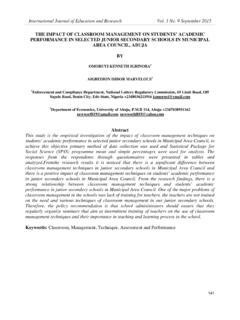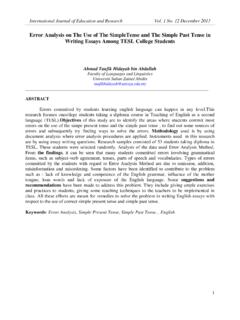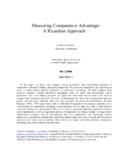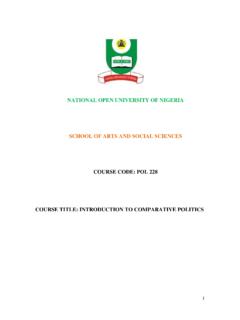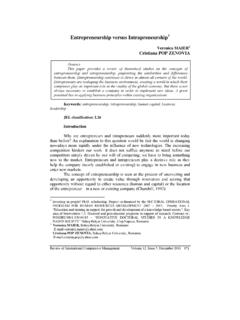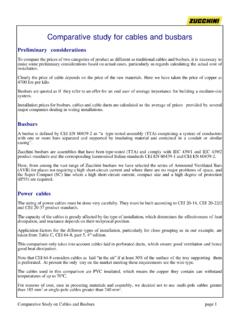Transcription of COMPARATIVE ANALYSIS OF BIODIESEL AND …
1 International Journal of Education and Research Vol. 1 No. 8 August 2013 1 COMPARATIVE ANALYSIS OF BIODIESEL AND PETROLEUM DIESEL Demshemino S. Innocent,O Donnell P. Sylvester, Muhammad F. Yahaya,IsiomaNwadike, and Linus N. Okoro. Department of Petroleum Chemistry and Engineering, American University of Nigeria, Lamido Zubairu Way, 2250 Yola Bypass, Adamawa State, Nigeria. Correspondence E-mail: Phone: +234805538671 Abstract The concerns on climate change, the high energy prices and the dwindling oil reserves and supplies have necessitated a strong interest in the research for alternative fuel sources. BIODIESEL is an alternative renewable fuel that has gained massive attention in recent on the physical properties of BIODIESEL have shown that it is completely miscible with petroleum diesel. Since the combustion of BIODIESEL emits particulate matter and gases which is lower than petrodiesel, combustion of BIODIESEL and BIODIESEL blends have shown a significant reduction in particulate matter and exhaust this review paper, the use of pure BIODIESEL or BIODIESEL blends in terms of performance and exhaust emissions has been studied in comparison to petroleum diesel.
2 Keywords: BIODIESEL , transesterification, performance, exhaust emissions, petrodiesel. Introduction As the population increases daily, the demand for energy to meet different lifestyle requirements increase as well. Consequently, the main concern has been on the use of various energy sources. Non-renewables such as fossil fuels like coal, wood, oil, and gas, are likely to be exhausted in the near future since they are nonrenewable as the name implies. These sources of energy cannot be renewed or reused. Alternative fuels from domestic sources are emerging as a solution to the declining reserves of fossil fuels, and the environmental unfriendliness resulting from the combustion of fossil fuels. The fuel that is consumed the most inEurope is BIODIESEL , a renewable mono-alkyl ester that is produced from vegetable oils, by a transesterification reaction.
3 The use of BIODIESEL in Europe from 2007 to 2010 represented a share of more than 80% of the transportation biofuel consumption, and of the total road transportation fuels consumption in 2010. (Serrano, Carreira, Carama, and Gameiro,2012). When fossil fuels are burned, a lot of carbon dioxide is released. Carbon dioxide is a gas that absorbs heat and contributes towards the greenhouse effect. Another gas released when fossil fuel is burned is sulfur dioxide which combines with water in the atmosphere to form sulfuric acid. This leads to acid rain which alters the ISSN: 2201-6333 (Print) ISSN: 2201-6740 (Online) 2 normal pH of soil that supports plant makes the world today consider the production and use of biofuels on a wide scale is the high level of atmospheric pollution caused by the intense use of fossil fuels leading to the greenhouse is against this backdrop that fuels namely; BIODIESEL and petroleum diesel are comparatively analyzed in this review paper.
4 Is BIODIESEL ? BIODIESEL is an animal or vegetable oil based diesel fuel that burns without the emission of much soot, carbon IV oxide and particulate matter. (Oliveira and Da Silva, 2013). It consists of long chain mono-alkyl esters and is produced by transesterifying vegetable oil or animal fat. In this process, the animal or vegetable oil is converted into BIODIESEL when one mole of triglyceride reacts with three (3) moles of alcohol to produce a mole of glycerol and three moles of mono-alkyl esters. BIODIESEL like petro-diesel is made of hydrocarbon chains that do not contain sulfur, or aromatics compounds in its composition. It is an alternative fuel that is obtained from renewable resources that burns in diesel engines with less environmental pollutants. ADVANTAGES OF BIODIESEL BIODIESEL is a fuel that has gained a lot of public attention because it is environmentally friendly and renewable and is being appreciated all over the world.
5 Among the many advantages of using BIODIESEL , some are listed as follows: the use of BIODIESEL is not dangerous to the environment. Petrodiesel-powered vehicles produce a considerable amount of emissions, and unfortunately the smokethese vehicles emit is hazardous to the is agriculture oriented, non-toxic, biodegradable and a renewable fuel. It has a high cetane number (a measurement of the combustion quality of diesel fuel during compression ignition), low sulfur, low volatility and presence of oxygen atoms in the fuel of the advantages of BIODIESEL fuel is that it can also be blended with other energy resources and development will generate employment opportunity for developing countries, where the level of unemployment is relatively high. BIODIESEL will also encourage the development of the agricultural sector.
6 (Aregbe,2010). DISADVANTAGES OF BIODIESELFUELS Although BIODIESEL has gained much scientific attention in recent years, it is not without some few disadvantages. One of the problems encountered when using BIODIESEL is the increase in nitrogen oxides emissions which can result in the formation of smog and acid rain. Similarly, BIODIESEL when compared to petro-diesel have a lower energy order to produce the same amount of energy, more biodieselis required than petro-diesel. Also, the use of valuable cropland to grow BIODIESEL crops could result to a rise in cost of food and furthermore leads to food scarcity (Aregbe, 2010). International Journal of Education and Research Vol. 1 No. 8 August 2013 3 What is petrodiesel? Petroleum diesel, also called petro-diesel, or fossil diesel is produced when crude oil undergoes fractional distillation between the temperatures of 2000C and 3500C at atmospheric pressure, to produce a mixture of carbon chains that contains between 8 and 21 carbon atoms per molecule.
7 Petroleum diesel is a fuel that is used to operate diesel engine-internal combustion engine. Most commonly, it refers to a specific liquid fuel obtained by the fractional distillation of petroleum, often called petro-diesel (Nikitchenko, ). Comparisons of BIODIESEL and Petro-diesel Performance COMPARATIVE ANALYSIS : The performance and emission features of compression ignition engines depends on the inner nozzle flow and spray performance. Inner nozzle flow and spray performance in an engine, controls the air fuel mixing, which is necessary for the process of combustion. Because of differences inthe physical properties of BIODIESEL and petro-diesel,the inner nozzle flow and spray structure are expected to be significantly altered and, consequently the performance and emission features of the diesel engine.(Som, Longman, Ramirez and Aggarwal, 2010).
8 Som et al (2010) in their research paper showed that because of lower vapor pressure of BIODIESEL , it was observed to cavitate less than petro-diesel. A reduction in injection velocity and loss of flow efficiency was also observed because BIODIESEL viscosity ishigher. In a review paper by Fallahipanah, Ghazavi, Hashemi, and Shahmirzaei(2011), the performance of BIODIESEL in an engine which completes a specific cycle was paperanalyzed BIODIESEL fuel and its compounds using thermodynamics laws as well as finite time thermodynamics. Their results showed that when BIODIESEL is applied as a fuel in the engine, similar results was obtainedand in some cases even better results wasobtained over petro-diesel the cycle work shown in figure 1, higher energy output can be achieved at higher compression ratios. Cumali, Selman, Rasim, and Huseyin(2011),experimented on a diesel engine using BIODIESEL fuel produced from sunflower oil with petro-diesel.
9 They found that using BIODIESEL in comparison to using petro-dieselincreased the brake specific consumption but a decrease in pollutants such as particulate matter and carbon monoxide. The poor lubricity of petro-diesel fuel has led to the failure of engine parts such as fuel injectors and pumps, because these parts are lubricated by the fuel was also reported that neat BIODIESEL possesses inherently greater lubricity than petro-diesel, especially low sulfur petro-diesel, and that adding BIODIESEL at low blend levels (1%-2%) to low-sulfur petro-diesel restores lubricity to the latter. (Goodrum and Geller 2005). In a research paper by Knothe and Steidley (2005), it was reported that BIODIESEL has a better lubricity than petro-diesel hydrocarbons, because of the polarity that is introduced with the presence of oxygen atoms which is lacking in petro-diesel.
10 Lubricity it was reported improves with the chain length and the presence of double bonds. One major technical advantages of BIODIESEL over petro-diesel is lubricity (Knotheet al, 2005). ISSN: 2201-6333 (Print) ISSN: 2201-6740 (Online) 4 Brake thermal efficiency (BTE) is defined as the ratio between power output and energy introduced through fuel injection (Christopher, Hillary, and Najeem, 2011). In a research conducted by Reddy, Shiva, and Apparao.(2010), on comparing the brake thermal efficiency of diesel fuel and cotton seed methyl ester ( BIODIESEL ) blends; it was found that the brake thermal efficiency is always found to be lower with BIODIESEL blends as compared with result from the experiment conducted by Christopher et al(2010) also showed that blending BIODIESEL with petro-diesel decreases the brake thermal efficiency (BTE) and on the other hand increases the brake specific fuel consumption (BSFC) which is defined as the rate of fuel consumption divided by the power produced.

